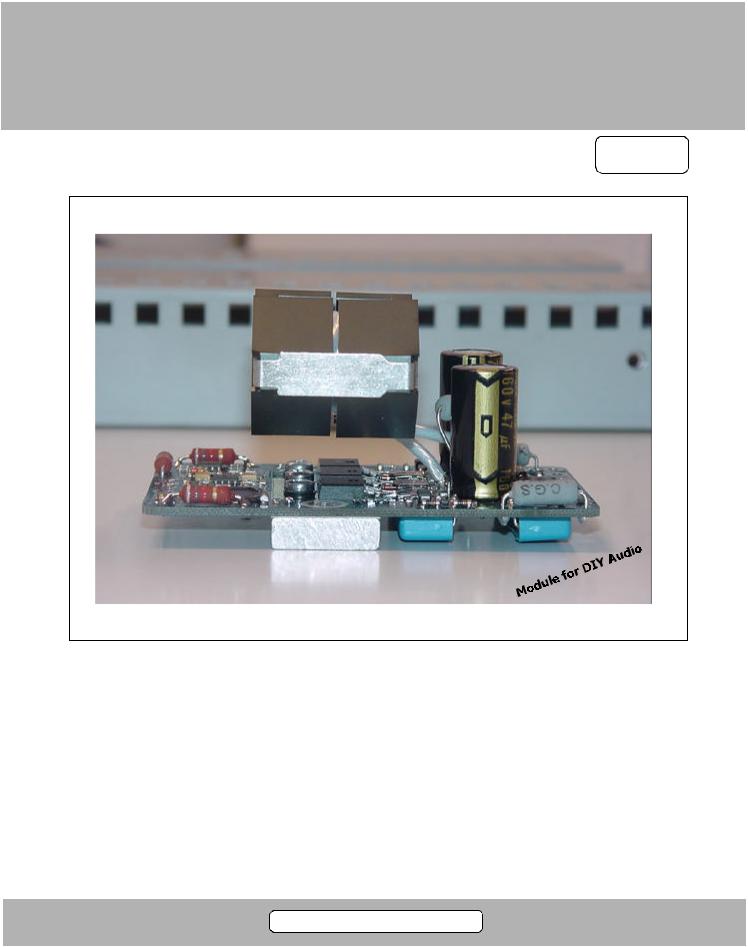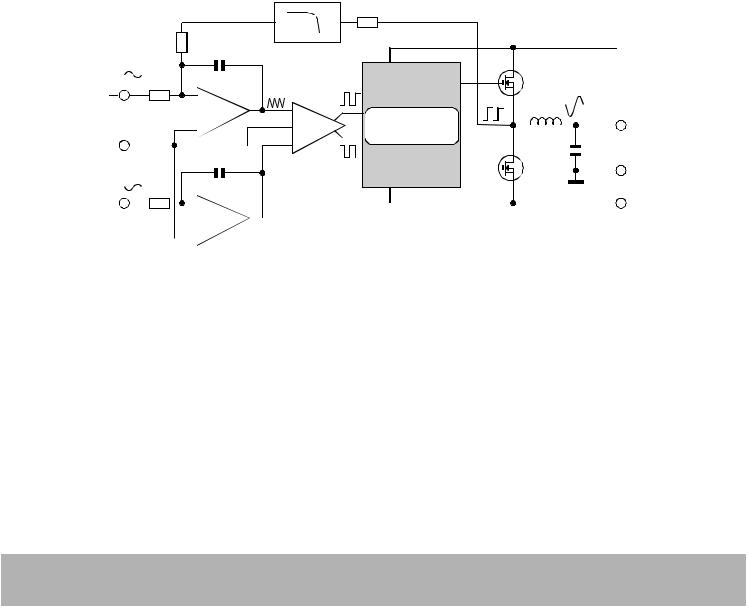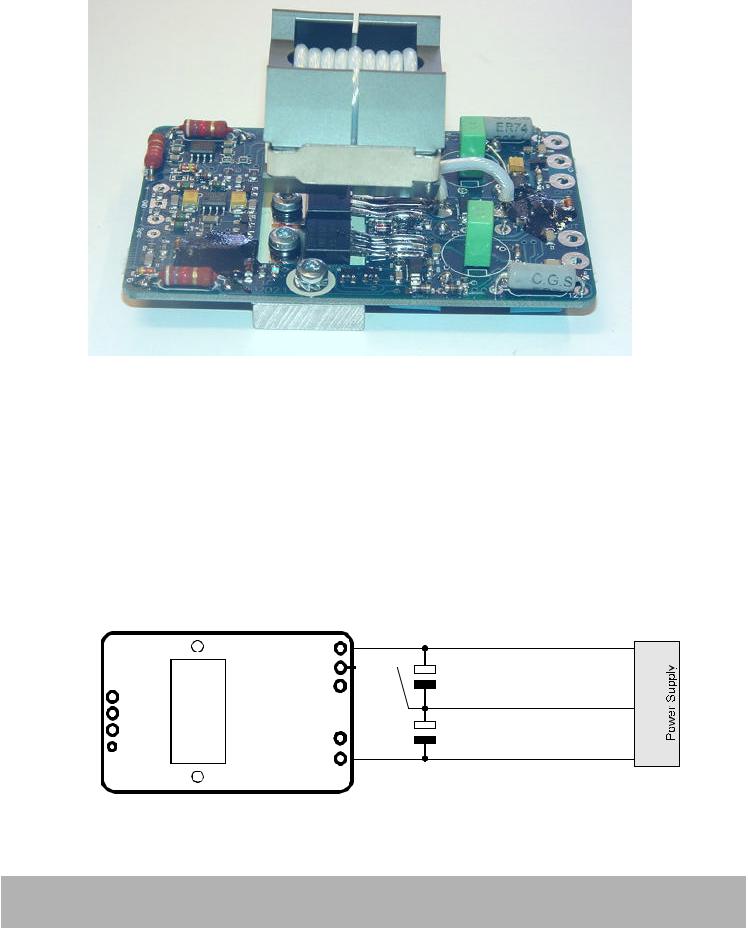LC Audio Technology Zappulse 2.1-SE Service manual

ZAPpulse 2.1
ZAPpulse 2.1 SE
COOKBOOK
P u l s e F i e l d
T e c h n o l o g y
Credit Card size
200 Watt RMS 8


290 Watt RMS 8
 (SE)
(SE)
ZAPpulse 2.1 og 2.1SE PWM High End Digital Audio Power Amplifier module. Balanced and unbalanced line input, Short Circuit Protection, 4 layer circuit board and controlled switching slope ensure minimal EMC emissions. Sound quality comparable to the best available analog power amplifiers.
ZAPpulse 2.1 uses supplies of 35 - 60 V DC and produces 200W RMS@8 Ohms, and up to 800 W RMS@2 Ohms.
ZAPpulse 2.1 SE runs on 35 - 72 V DC and produces 290 W RMS@8 Ohms and more than 1050W RMS@2 Ohms. 2.1 SE is equipped with Black Gate VK.
Dynamics, Soundstage, natural musical perception, clarity, warmth!
L C Audio Technology Ltd. Denmark

Content.
Bridge coupling of 2 ZAPpulse modules |
8 |
Compensated Mode |
11 |
Complete Amplifier, Schematic |
14 |
Cooling Requirement |
17 |
InputOutput connections |
7 |
Mechanical Data |
20 |
More ZAPpulse technology |
4 |
Minimum System |
17 |
Output power Correlation with Supply Voltage |
6 |
Passive Volume control |
7 |
Power Supply Connections |
5 |
Principle of operation |
3 |
Professional use |
19 |
Shopping List |
18 |
Surround System |
19 |
Switching frequency considerations |
9 |
Syncronous Mode |
16 |
Technical Data |
12 |
ZAPpulse 2.1 with Active Crossover |
19 |
Further information: www.lcaudio.com
ZAPpulse 2.1 |
2 L C Audio Technology Inc. |
Copying and distribution of this material for pesonal use is allowed. No commercial use of this material is allowed without written permission from L C Audio Technology.

Principle of Operation.
In a conventional amplifier the input signal is amplified through various analog stages to a progressively higher amplitude. In the final stages of the amplifier, the output stage, high current capability is added to enable the amplifier to drive loudspeaker loads. When current is drawn out of the output stage to the load, heat is dissapated in the output stages, since the load current multiplied with the voltage drop over the output device gives a power value (of average 60% of the max. output power) that needs to disappate in heatsinks. 60% is not the power loss
at maximum output power, but the average heat disappated at various output power levels (except very small levels below 1W). So a 100 Watt amplifier will averagely need to disappate 60 Watts power into heatsinks. The ZAPpulse operates in a different way, the output devices are either on or off with no significant voltage drop, so even when the load draw large amounts of current, there is only minimal power to be disappated. To control the signal amplitude, the pulse width of the output square wave is controlled very accurately.
Filter
 +60V
+60V
Gnd |
|
|
|
|
|
|
|
|
|
P u l s e F i e l d |
|
|
|
|
|
|
|
Out |
|||
|
|
|
|
|
|
|
|
|
T e c h n o l o g y |
|
|
|
|
|
|
|
|
||||
|
|
|
|
|
|
|
|
|
|
|
|
|
|
|
|
|
|
||||
|
|
|
|
Integrator |
|
|
Gate Driver |
|
|
|
|
|
|
|
Gnd |
||||||
|
|
|
|
|
|
|
|
Differential |
|
|
|
|
|
|
|
|
|
||||
|
|
|
|
|
|
|
|
|
|
|
|||||||||||
|
|
|
|
|
|
|
|
|
|
|
|
|
|
|
|
|
|||||
|
|
|
|
|
|
|
|
|
|
|
|
|
|
|
|
|
|
||||
|
|
|
|
|
|
|
|
Comparator |
|
|
|
|
|
Output Filter |
|||||||
|
|
|
|
|
|
|
|
|
|
|
|
|
|
|
|||||||
+ |
|
|
|
|
|
|
|
|
|
|
|
|
|
|
|
|
|
|
|
|
-60V |
|
|
|
|
|
|
|
|
|
|
|
|
|
|
|
|
|
|
||||
|
|
|
|
|
|
|
|
|
|
|
|
|
|
Output Stage |
|||||||
|
|
|
|
|
|
|
|
|
|
|
|
|
|
||||||||
|
|
|
|
|
|
|
|
|
|
|
|
|
|
|
|
|
|
|
|
|
|
After the output devices the square wave need to be filtered with a choke and capacitor, to get an analog output signal without noise that can be fed to the loudspeakers. The choke and capacitor's quality is paramount in order to get a good sound quality, so we use an oversized (1.5 kW) ultra high speed ferrite core with silver conductor and TEFLON insulator. This choke has a very low impedance of only 5 milli Ohms, and allows for a good damping factor in any speaker load. To get an output signal of say 30V, the output devices are made to switch high 75% of time, and 25% of time low. In this case
the Pulse Width is 75%, since the V+ - V- is 120V, the output voltage seen from V- is 75% of 120V = 90V. 90V on top of -60V is 30V, as wanted in our example. Operating from +60V to -60V allows for any output voltage in this range, including 0V. Thus a total DC coupled system for highest possible sound performance. Pulse Width Modulation is often shortened to PWM. A very important stage in a PWM amplifier is the modulator, that can be made i various ways, with different properties. We have selected and optimized the balanced integrating type, as it is highly stable, and has very low distortion.
ZAPpulse 2.1 |
3 L C Audio Technology Inc. |
Copying and distribution of this material for pesonal use is allowed. No commercial use of this material is allowed without written permission from L C Audio Technology.

More ZAPpulse 2.1 Technology!
The heart of the ZAPpulse amplifier is a balanced integrating PWM modulator. It basicly integrated the DC level of on switching cycle of the output stage, including any switching noises, slope differences etc. Then this value is compared, and corrected in the next switching cycle to create an output signal of exactly 0 Volt. This correction is performed every switching cycle, which is about 500.000 times per second.
The input signal is injected directly into the integrator to keep signal paths ultra short. No signal conditioning, such as DC blocking, HF blocking or other limiting factors are present on the ZAPpulse module. So if this is required by your application, you have to add these functions outside the module. When signal is applied to the input, the integrator no longer corrects the output signal level to 0 Volts, but rather to the signal curves.
The feedback group delay is kept very low, only around 2 uS, to allow for TIM free operation. The analog integrating feedback loop has a lower group delay of any completely digital (A/D based) feedback loop. And since output switching noise products are the same no matter the modulator type, the analog feedback loop gives a much better rejection of noise products than a true digital approach. It's all about speed, and how fast the noise can be cancelled.
The output square wave has a base frequency of typ. 500 kHz, and rise times of some 10.000 V/uS. The slopes are minimised to around 50nS to keep
switching losses low at heavy speaker loads. However at low signal amplitudes the main power loss comes from capacities in the MOSFET's, so transitions are slowed to reduce EMI, noise and idle loss. This is controlled by the PulseField circuit in the Gate driver.
A simple rule says that at no signal, a ZAPpulse loses some 9.5 Watts power to capacities in the MOSFET's, and at full power it loses another 9.5 Watts to serial resistance. So at 500 W out you only have to disappate around 19 Watts to the heat sinks.
One great advantage PWM amplifiers have over conventional analog amplifiers is, that in the analog amplifier it is difficult to avoid the harmonic distortion products, that are signal dependent, and therefore interacts with sound quality. In the PWM amp, the distortion is non-harmonic, and independent of signal contents. In sonic performance properties this translates to the PWM amplifiers exceptional ability to expand the sound stage with added sound level. An analog amplifier would typically collapse the soundstage at higher levels, depending on the size of the power supply (why we have huge power supply banks in all our analog amplifiers). The PWM will play with wide and deep sound stage at any lisytening level, even with a very (almost too) small power supply. We have made tests with a 2 x 250 W RMS ZAPpulse amp, running with only two 2200 uF 100V main caps. And it still has plenty of bass control, definition, width and depth. Opportunities for interesting experiments in this field are obvious.
ZAPpulse 2.1 |
4 L C Audio Technology Inc. |
Copying and distribution of this material for pesonal use is allowed. No commercial use of this material is allowed without written permission from L C Audio Technology.

ZAPpulse 2.1
Connection of Power Supply.
To make ZAPpulse 2.1 work, simply connect a typical Audio Power Supply of +/-35V to +/-60V (+/- 72V for SE version). The output power depends on the voltage of the power supply. The 2.1 standard version uses 63V capacitors, on the board, while the 2.1 SE uses 160 V caps. This is why the SE can be made to deliver much higher powers than the standard modules. In the standard version, the sound quality of the main caps must be considered.
The midrange and treble sonic properties of these caps, will interact with the overall sound performance of the amplifier, so we recommend using very high quality caps with standard modules. With the SE modules the mid and high frequency performance is fixed at the highest level by the Black Gate VK caps (47 uF 160V). So PSU caps only need to have good bass props. Always use short and heavy wire between PSU caps and modules
(< 4-5 inches).
|
|
+60V |
|
|
SHORT! |
|
+60V |
||
|
|
Power |
|
|
SHORT! |
10.000uF |
|||
|
|
GND |
|
|
|
|
|||
|
|
Power |
|
|
|
|
|
63V |
|
|
|
GND |
|
|
|
|
|
|
|
|
|
|
|
|
|
|
|
|
Power |
|
|
|
|
|
|
|
|
|
GND |
|
|
|
|
|
|
|
|
||
|
|
|
|
|
|
|
|
10.000uF |
|
|
|
OUT |
|
|
|
SHORT! |
63V |
||
|
|
|
|
|
|||||
|
|
-60V |
|
|
|
|
-60V |
||
|
|
|
|
|
|
|
|
||
|
|
|
|
|
|
There is no need for huge capacitor banks, 2 pcs. |
|||
|
|
|
|
|
|
10.000 uF wil do fine for any normal speaker load. At |
|||
|
|
|
|
|
|
2 Ohms load, maybe 2 pcs. 22.000 uF will work perfectly. |
|||
|
|
|
|
|
|
All energy in the capacitor bank is translated almost |
|||
|
|
|
|
|
|
lossless to audio power. Practical experiments show that |
|||
|
|
|
|
|
|
even with only 2200uF these modules will deliver |
|||
|
|
|
|
|
|
incredible high performance Audio sound. (8 Ohms speakers). |
|||
ZAPpulse 2.1 |
5 |
|
L C Audio Technology Inc. |
||||||
Copying and distribution of this material for pesonal use is allowed. No commercial use of this material is allowed without written permission from L C Audio Technology.

Correlation of Output Power and Supply Voltage.
The Output power can be calculated as a result of the max. signal amplitude, which depends on the supply voltage. At +/- 60V Supply Voltage the amp can ideally deliver 120 Vpp. To calculate the output power we need the RMS value, which is simply 120 / 2pi = 120 / 2,82 = 42,6 Vrms (in this example).
Output power is then calculated using Ohms Law:
In this example 223 watts RMS.
This was ideal values, in ZAPpulse the practical values are corrected with a serial loss of 1 - 3 VDC depending on load impedance (1 V @ 8 Ohms).
At +/- 60 VDC you will get a practical output power of: some 210 Watts RMS.
P = U2
R
P = Output Power RMS
U = RMS Voltage (42,6)
R = Speaker Impedance (8)
See below for output powers at other transformer voltages, and load impedances.
Bottom table shows bridge mode ZAPpulse modules operating at very high power!
Transformer Voltage |
DC Voltage after Rect. |
P out in 8 Ohms |
P out in 4 Ohms |
2 x 24 V AC |
+/- 32 V DC |
60 W |
106 W |
2 x 27 V AC |
+/- 36 V DC |
78 W |
137 W |
2 x 33 V AC |
+/- 45 V DC |
119 W |
222 W |
2 x 36 V AC |
+/- 49 V DC |
144 W |
266 W |
2 x 40 V AC |
+/- 55 V DC |
180 W |
340 W |
2 x 42 V AC |
+/- 58 V DC |
200 W |
380 W |
2 x 45 V AC |
+/- 62 V DC |
230 W |
438 W |
2 x 50 V AC |
+/- 69 V DC |
286 W |
548 W |
You can also bridge two ZAPpulse modules to get a much higher output power. See how later in this booklet.
Transformer Voltage |
DC Voltage after Rect. |
P out in 8 Ohms |
P out in 4 Ohms |
2 x 24 V AC |
+/- 32 V DC |
219 W |
397 W |
2 x 27 V AC |
+/- 36 V DC |
286 W |
526 W |
2 x 33 V AC |
+/- 45 V DC |
448 W |
837 W |
2 x 36 V AC |
+/- 49 V DC |
542 W |
1019 W |
2 x 40 V AC |
+/- 55 V DC |
682 W |
1291 W |
2 x 42 V AC |
+/- 58 V DC |
758 W |
1439 W |
2 x 45 V AC |
+/- 62 V DC |
879 W |
note |
2 x 50 V AC |
+/- 69 V DC |
1100 W |
note |
note: We can NOT guarantee the modules to operate safely with this load.
ZAPpulse 2.1 |
6 L C Audio Technology Inc. |
Copying and distribution of this material for pesonal use is allowed. No commercial use of this material is allowed without written permission from L C Audio Technology.
